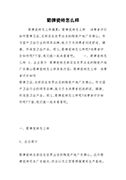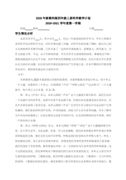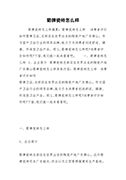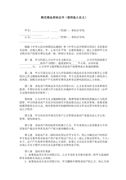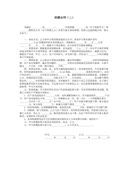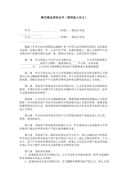《Unit 6 Meet my family!》教案(通用2篇)四年级英语教案
《Unit 6 Meet my family!》教案(通用2篇)
《Unit 6 Meet my family!》教案 篇1
(人教pep)unit6 meet my family教案
the first period
teaching contents:part a let’s learn group work partc good to know
teaching aims:
grasp the words: family, parent, aunt, baby brother.
enable the students to describe the family with simple sentences.
difficulties and importance:
enable the students to grasp these words.
enable the students to understand the differences between “parent” and “parents”; “uncle” and “aunt”.
preparation: word cards and pictures of the family
teaching procedure:
warm-up: let’s chant.
preview
let’s do
let’s play a game. who’s missing?
activity: talk about the family’s member.
ex: this is my father. he is strong. he has short hairs.
presentation
teaching words: family, parent, uncle, aunt.
listen & paste.
sing a song.
let’s chant.
a survey: do you have uncle? how many uncles do you have?
listen and do.
read after the tape.
consolidation and extension
group work
draw your family; introduce your family.
good to know
activity book: let’s learn.
the second period
teaching contents:parta let’s talk let’s practise
teaching aims:
understand and enable the students to make the similar dialogue with their families’ pictures.
enable the students to use the sentences: how many … are there…?
difficulties and importance:
enable the students to catch the meaning and read the passage.
enable the students to use the sentences: how many …are there..?
preparation: pictures of the family (both teacher and students)
teaching procedure:
warm-up.
let’s chant.
let’s do.
put your erase on your desk. put your pencil in the bag. out your pencil=case under your bag. put your book on your head. put your activity book near your eraser.
preview
free talk: a. where’s your book/…? how many books do you have? where are they?
[picture]how many people? who are they?
presentation
teaching: who’re they? they’re…
look. this is my family. who’re they? they’re my father, my mother and me.
read after me.
guessing game: who’re they?
teaching: how many… are there…?
there are 3 people in my family. how many people are there in your family?
pracitice in groups.
a survey: how many people are there in your family?
teaching: my family has … members.
make a statistics of the survey.
my family has 3 people. how many people are there in your family?
teaching: that’s only …
teaching: puppy
read after the tape. explain “gee!”
let’s practice.
consolidation and extension
game: how many …are there…?
finish the activity book.
《Unit 6 Meet my family!》教案 篇2
小学教育是基础教育的起点,是培养和造就人才的关键阶段。小学阶段的教学,应从儿童的各种兴趣入手,实施“兴趣教育”,全方位提高学生的思想素质、科学文化素质、身体与心理素质。英语的“兴趣教学”是培养和训练学生听说能力的重要手段,是促进学生学习英语形成良好习惯的重要环节,是巩固学生学习英语和提高英语质量的有效保证,是达到低年级英语教学目的的关键。而在小学英语基础教育阶段的课程任务是通过各种教学活动,激发和培养学生学习英语的兴趣,养成良好的学习习惯和形成有效的学习策略,发展自主学习的能力与合作创新的精神,培养学生综合运用英语的能力。因此,在小学英语教学中必须为学生提供充分的运用英语口语进行交往实践的机会,使学生从中加深理解、熟悉运用、牢固掌握,达到学以致用的目的。这节英语课就以上所述的目标为准则进行设计、教学的。
一、本节课的教学内容与要求
本案例是pep book3第六单元的第四课时。通过这节课的学习能够听、说、认读5个职业单词,并能介绍人物的职业;能听懂、会说句型what’s your father ? my mother is a doctor. 了解英语国家中家庭成员之间的称呼习惯;并能积极的运用所学英语进行表达、交流,从而进一步激发和培养学生学习英语的兴趣,发展自主学习的能力以及综合运用英语的能力。
二、教学设计
(一)warm-up
listen and do:
t: walk/jump/run/swim/play ping pong/ play basketball/play volleyball…
lead-in:drive the bus/drive the jeep/drive the car(cai shows the word: drive)
(二)presentation and practise
1、teach “driver”
a、drive the car, drive the car, he is a driver.→driver (er,er,…)
b、ss read: driver ,driver ,he is a driver.
c、t: guess,what colour cars does the driver like?
s1: he is a driver. he likes …cars.
(cai)ss: he is a driver. he likes blue cars.
2、teach “farmer”
a、t: let’s drive the car to the farm.(cai shows the word: farm)
b、let ss listen to the poem
t: what’s he? →farmer( er , er ,…)
c、ss read: farmer, farmer, he is a farmer.
d、t: guess, what’s the farmer’s hobby?
s1: he is a farmer. he likes …
(cai) ss: he is a farmer. he likes playing balls.
3、teach“baseball player”
a、t: what kinds of balls do you like?
s1:i like…
b、t: the farmer likes playing many kinds of balls.look!
(cai)football beckham→football player
basketball yao ming→basketball player
ping pong kang linghui→ping pong player
(teach the word :player er,er,…)
baseball a boy→baseball player
c、ss read: player , player, a baseball player
d、(t shows a toy baseball stick)
t: i’m a baseball player.(t pass it to s1)
e、play one by one
s1: i’m a baseball player.
s2:…(注:本环节对说得好的学生奖励印有baseball player的职业徽章)
4、teach the sentence: what’s he ?
a、(cai:象征职业人物的黑影图)
t: what’s he ?
s1: he’s a baseball player/driver/farmer…→
what’s he ?
b、ss read : what’s he ?
c、ss ask: what’s he/she? s1:he’s/she’s a…
5、teach: doctor
a、 (cai)t: what’s he ? →doctor
b、ss read: doctor, doctor, he is a doctor.
c、t: i don’t like doctors. what about you ?
s1:i like/don’t like doctors.
t: so i eat an apple a day. because there is a saying:an apple a day keeps the doctor away.
ss read the sentence.
d、let ss sing the song: an apple a day
6、teach: nurse
a、t shows some tools (e.g. 听诊器、司机帽、护士帽…)
s1给s2戴上工具,s1:what’s he /she? s3:he/she is a …
b、t shows a nurse cap and put it on a girl’s head and ask: what’s she ? →nurse
c、ss read: nurse,nurse,she is a nurse (ur,ur…)
cai shows 6 nurses.
t: i like nurse1.she is kind. group work:4 students discuss
s1:i like nurse…. she is….
(注:本环节对说得好的学生奖励印有nurse的职业徽章)
(三)consolidation and extension
1、review the words
a、read all the words
b、listen and do
t: act like a driver… ss do action
c、let ss open the books and read “let’s learn”and practice “let’s do “
d、 ss practise: let’s do
2、homework
a、设计一张二十年后自己的名片
b、搜集其他职业的英语表达方法
三、教学反思
当代教育主张“开放式课堂教学”,注重培养创新型人才。基于这一理念,在教学设计过程中,我结合教材和学生的特点,依据新英语课程标准的精神,以及教学要求、结合教学内容有意识地充实了丰富有趣、针对性强的开放性游戏活动,科学安排教学内容,合理设计教学任务,开展形式多样的教学活动,使孩子们在“乐中学、学中乐”,从而激发学生的学习兴趣、培养良好的学习习惯、丰富生活经验和提高认知水平。但是这节课过于追求创设情景,甚至是为了情景而情景,以至于产生了虚假的情景。如在以黑影出示,让学生猜猜是什么职业,这一教学用意较好,但是学生却以此为由大声讲话或者乱猜一番,影响了教学流程。我本想让学生们情景中以自然习得英语,但是并不是你想的那么简单。原本就是无本之木,无源之水,显然这么做是有点不切合实际的。
在我们现实的小学英语教学中,有限的师资力量,教师水平的相对低下,语言环境的缺乏,大规模的班级授课,都告诉我们直接法的教学方法不适合目前的小学英语的教学实际。这节课中就是以直接法为主进行教学的。以直接法教学,一定要有语言环境,要有高水平的师资,班额要小,学习和使用英语的机会要多,可本节课创设的语言环境还不够,而且班额数又大,以致教学效果欠佳。本节课可以运用认知法进行教学,以语言知识为拐杖,运用经验学习的同时,注意理性认知,培养小学生可持续发展的语言学习能力。
本节课运用了猜颜色,猜职业,表演等游戏来激发学生学习兴趣,活跃课堂气氛,但学生只过于对游戏的热忠,而忘了知识的巩固、积累,教学过程中被游戏所累。导致教学节奏和教学时间的把握上不准确,使得教学节奏稍慢了点,以致在最后的任务活动中没有留有足够的时间给学生去思考、练习和展示。小学英语教学是要重视培养兴趣,但不能单靠唱歌游戏去学习,因为培养兴趣主要是为了学习英语。小学生学习英语不是英美的移民学习英语,则只有不断学到语言知识,提高语言能力,满足他们的成就感,才可能培养持久的兴趣。唱歌游戏应该作为小学生学习英语语言知识、技能的一些手段,而不是培养兴趣的手段。我们可以采用多种手段帮助小学生在记忆力强的时期多记单词,多学习语言规则,并尽可能多创造模仿的机会,提高学生的语音和语调。


